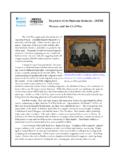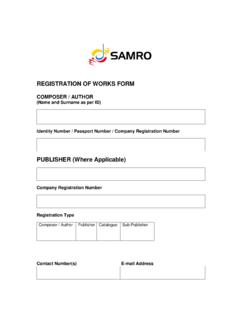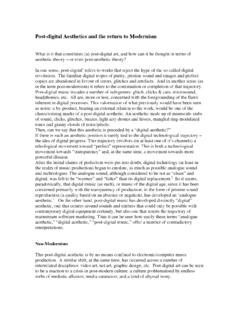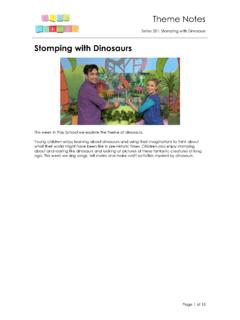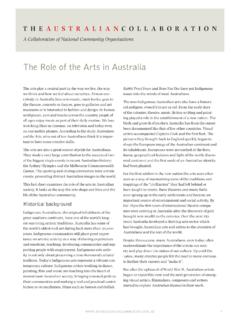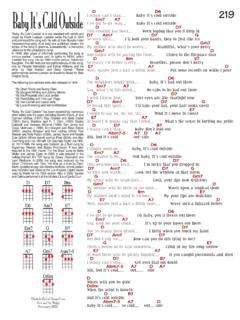Transcription of PRIMARY SOURCE SET: J CROW IN AMERICA
1 Historical Background Jim Crow, or segregation, laws of the late 19th and early 20th centuries effectively divided the Ameri-can South into black and white in almost every as-pect of public life. The laws codified practices that had developed over many decades during and after slavery, and the laws made the custom of racial separation much more rigid. Jim Crow laws ex-tended to restaurants, hotels, theaters, bus stations, parks, public restrooms and drinking fountains, public schools, and the United States military. The term Jim Crow grew out of nineteenth-century minstrelsy and was first applied to segre-gated facilities in the pre-Civil War North. While there is evidence of the passage of some scattered Jim Crow laws in the South during Reconstruction, segregation enforced by law did not immediately replace slavery in the aftermath of emancipation.
2 During the 1870s and 1880s, however, states be-gan to pass Jim Crow laws, with one of the first passed by Tennessee in 1875. By 1896, the Supreme Court ruled in Plessy v. Ferguson that separate but equal did not violate the 14th Amendment of the Constitution. Jim Crow placed a stigma on African Americans and promoted the idea that they were second-class citizens. At the same time, however, Jim Crow encouraged black entrepreneurship and a strong sense of community within black schools and neighborhoods. In sum, though, the costs of Jim Crow far outweighed any benefits. Civil Rights leaders began their effort to dismantle segregation by focusing on the inequality between black and white schools in the South. The Civil Rights move-ment finally brought an end to segregation by law with the Supreme Court decision in Brown v.
3 Board of Education (1954) and passage of the Civil Rights Act of 1964. SUGGESTIONS FOR TEACHERS Students today often have a difficult time under-standing Jim Crow laws and their pervasiveness a century ago. You can find a wide variety of sources on the Library of Congress Web site to illustrate the presence of segregated facilities, schools, and businesses in American history. You can use these sources to initiate class discussion around this difficult topic. Begin by having students analyze the sources looking for evidence of Jim Crow. Discuss these questions together: Are there more images that designate colored places or white places? If a facility did not have a sign, what do you think it was assumed to be, and how would that have sug-gested a distinction between the races? How might each example of Jim Crow have influenced an individual, both black and white?
4 Did colored facilities always appear inferior to white facilities? What benefits might some Af-rican Americans have found in separate facilities? What would have been some of the practical costs to communities of enforcing Jim Crow? How do the signs make you feel today? Negro drinking at "Colored" water cooler in streetcar terminal, Oklahoma City, Ok-lahoma [1939 July] Teaching with PRIMARY Sources MTSU PRIMARY SOURCE SET: JIM CROW IN AMERICA Jim Crow [Between 1835 & 1845] Supreme Court of the United States Plessy v. Ferguson [1896] To the Colored Men of Voting Age in the Southern States [190?] Jump Jim Crow [between 1966 and 1968] Click here for an audio recording. LINKS A guide to Harlem Renaissance material PBS Rise and Fall of Jim Crow: Games and Activities Today in History: The Fourteenth Amendment Political Cartoon Analysis Guide Race Relations in the 1930s and 1940s A timeline of African American History TPS-MTSU Newsletter June 2017 Atlanta Exposition Speech [1895] Tuskegee History Class [1902] Washington, Booker Taliaferro [1903] Alabama Hall, Tuskegee In-stitute, Ala [1906] President Roosevelt and Booker Washington reviewing the 61 "industry" floats, Tuskegee, Ala [1906] Flag announcing lynching, flown from the win-dow of the NAACP head-quarters on 69 Fifth Ave.
5 , New York City [1938] Report of Anti-Lynching Com-mittee [January 21, 1921] Lynch law in Geor-gia :a six-weeks' record in the center of southern civiliza-tion, as faithfully chronicled by the Atlanta journal and the Atlanta constitu-tion [1899] The broad ax (Salt Lake City, Utah) [1922] Ida B. Wells in The Topeka State Journal. NIGHT ADDITION, [1895] Zora Neale Hurston [1938 April 3] Listen Here Bessie Smith Wasted Life Blues Manuscript copy [1929] The Memphis Blues [1913] Drafts of Lang-ston Hughes s Poems Ballad of Booker T. [1941] Duke and his group on the cover of Down Beat Magazine [1946] Listen Here Portrait of Louis Armstrong, between 1938 and 1948 [1938] Click for more on Armstrong Negro carrying sign in front of milk company [1941] Apartment building in Negro section of Chicago, Illinois [1941] Ev'rybody's crazy 'bout the doggone blues but I'm happy [1918] Listen Here Kenneth L.
6 Kusmer, Ed. The Great Migration and After, 1917 1930, vol. 5, p. 4. Black Communities and Urban Development in AMERICA , 1720 1990 [1917-1930] Smoke billowing over Tulsa, Oklahoma during 1921 race riots [1921] The broad ax. (Salt Lake City, Utah) 1895-19??, August 02, 1919, Image 1 [1919] Clayton s Weekly. (Seattle, Wash.) 1916-1921 [1920] Washington, Portrait of A. Philip Ran-dolph, labor leader [1942] The Kansas City sun. (Kansas City, Mo.) 1908-1924, December 06, 1919, Image 3 [1919] A. Philip Randolph to NAACP Secretary Walter White, March 18, 1941. Typed letter. NAACP Records [1941] Marcus Garvey, 1887-1940 [1924] (William Edward Burghardt) Dubois, 1868-1963 [1919] Click here to hear Dubois speak about his activism Silent protest parade in New York [City] against the East St.
7 Louis riots, 1917 [1917] Click here for Teacher s Guide (NAACP) Members of the British arm of the NAACP protest against American violence against blacks [between 1910 and 1940] 20th Annual session of the , 6-26-29, Cleve-land, Ohio [1929] Niagara Movement Founders [1905] Drinking fountain on the county courthouse lawn, Halifax, North Carolinav[1938 April; detail] Beale Street, Memphis, Tennessee [1939 Oct? ] Secondhand clothing stores and pawn shops on Beale Street, Memphis, Ten-nessee [1939 ] At the bus station in Durham, North Car-olina [1940 May; detail] Tourist cabins for Negroes. Highway sign. South Carolina [1939 June] Jim Crow Resort? [1915] Colored School at Anthoston. Census 27, enrollment 12, attendance [1916 September 13; detail] Fisk University, Nashville, Tenn., 1900 - Theological Hall [1900?]
8 ] Click here for more images of Fisk Uni-versity. Pleads for Jim Crow School [1915] Pleasant Green School--one-room colored school near Marlinton, W. [1921 Oct. 6; detail] Cadentown Rosenwald School, Caden Lane, Lexington, Fayette County, KY [1933] Lesson Plan Washington, Campus of Howard University [1942] CITATIONS: Jim Crow in AMERICA Teachers: Providing these PRIMARY SOURCE replicas without SOURCE clues may enhance the inquiry experience for students. This list of citations is supplied for reference purposes to you and your students. We have followed the Chicago Manual of Style format, one of the formats recommended by the Library of Congress, for each entry below, minus the access date. The access date for each of these entries is 5/16/17. Lee, Russell, photographer. Negro drinking at "Colored" water cooler in streetcar terminal, Oklahoma City, Ok-lahoma.
9 Nitrate negative. July, 1939. From the Library of Congress, Farm Security Administration/Office of War Infor-mation Black-and-White Negatives. Rice, Thomas Daddy , composer. Jump Jim Crow [transcription]. Transcribed by Alan Jabbour, from a perfor-mance by Henry Reed. Manuscript. Between 1966-1968. From the Library of Congress, Fiddle Tunes of the Old Frontier: the Henry Reed Collection. Hodgson, publisher. Jim Crow Etching and Ink. Between 1835-1845?. From the Library of Congress, Prints and Photographs Division. Wright, , publisher. To the Colored Men of Voting Age in the Southern States. 190?. From the Library of Congress, African American Pamphlet Collection. :@ Banks and Brothers Law Publishing. Supreme Court of the United States. Plessy v. Ferguson 1896. From the Li-brary of Congress, Law Library of Congress.
10 Cheynes Studio, photographer. Washington, Booker Taliaferro. Film negative. 1903. From the Library of Con-gress, African American Perspectives. Johnston, Francis Benjamin, photographer. History Class, Tuskegee Institute, Tuskegee, Alabama. Photographic print. 1902. From the Library of Congress, Library of Congress Prints and Photographs Division Washington, Washington, Booker T., publisher. Atlanta Exposition Speech [transcription]. Manuscript. September, 1895. From Library of Congress, African American Odyssey. :@ Underwood & Underwood, publisher. President Roosevelt and Booker Washington reviewing the 61 industry floats, Tuskegee, Ala. Photographic print. C1906. From the Library of Congress, Library of Congress Prints and Pho-tographs Division Washington, The Topeka State Journal.
